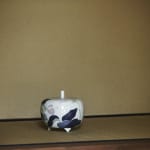Kusube Yaichi (1897−1984)
Saien Incense Burner Named “Summer Day”
Sealed sign “ya” on foot
With a Kusube Atsuko certificate, a box signed by the artist, double boxed
W12.5 x H11 cm
Further images
Generally regarded as crafts of utility, the genre of ceramics and its value are often considered in the dualism of functionality and aesthetic value. There are two trends coexist in the postwar Japanese ceramics: the avant-garde ceramics that concentrates on creating works free from the restriction of its functionality; and the Mingei Movement that praises the functional beauty found in everyday utensils by anonymous craftsmen. Kusube Yaichi had sympathies with both sides, nonetheless pursued a distinctive path of his own by producing ceramic works that stand as fine art pieces themselves, while staying in the form of traditional crafts of utility.
Saien, or design in color clays, is Yaichi’s original technique of creating motifs of relief effect by thin application of clays mixed with color glazes. In this way, motifs no longer appear as paintings, but rather is treated as part of the form of the whole work made of clay. Color, motif, and form become a harmonious entirety. The present work adopts a soft color palette that gracefully balances the colors and forms of summer flowers and grasses. It indeed presents Yaichi’s alternative solution to the ceramics’ functionality and aesthetic value dualism, and can be said as a true modern ceramic masterpiece.
Kusube Yaichi (ceramist; 1897–1984)
Kyoto-born ceramist. Apprenticed at the Kyoto tojiki shikenjo (Kyoto research institute for ceramics). Initiated the ceramists’ group Sekido-sha and became active in the field since then. Exhibited at Teiten, Nitten, among other exhibitions. Leader of Seito-kai. Consultant to Nitten. Member of the Japan Art Academy. Designated as a Person of Cultural Merit and received the Order of Culture.
Saien, or design in color clays, is Yaichi’s original technique of creating motifs of relief effect by thin application of clays mixed with color glazes. In this way, motifs no longer appear as paintings, but rather is treated as part of the form of the whole work made of clay. Color, motif, and form become a harmonious entirety. The present work adopts a soft color palette that gracefully balances the colors and forms of summer flowers and grasses. It indeed presents Yaichi’s alternative solution to the ceramics’ functionality and aesthetic value dualism, and can be said as a true modern ceramic masterpiece.
Kusube Yaichi (ceramist; 1897–1984)
Kyoto-born ceramist. Apprenticed at the Kyoto tojiki shikenjo (Kyoto research institute for ceramics). Initiated the ceramists’ group Sekido-sha and became active in the field since then. Exhibited at Teiten, Nitten, among other exhibitions. Leader of Seito-kai. Consultant to Nitten. Member of the Japan Art Academy. Designated as a Person of Cultural Merit and received the Order of Culture.









